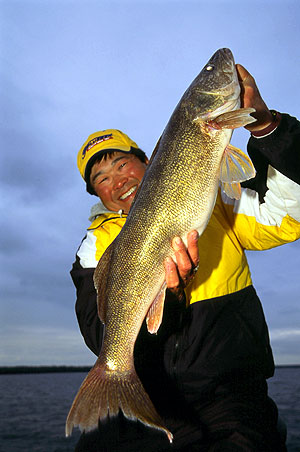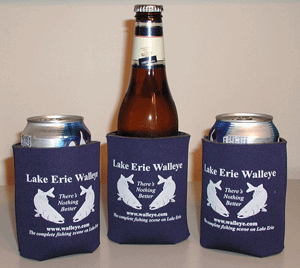| |
The Hunt
for Trophy Fish
by Ted Takasaki and Scott Richardson
Who has ever dreamed about catching a trophy walleye of
lifetime? We all yearn to see an 8, 9, 10 pound fish or even larger
splashing on the surface as we slip it into the net!
Walleyes are a challenging fish to catch consistently and trophy
walleyes
 are
even tougher. Perhaps more than any other game fish, walleyes can
be found utilizing many different types of habitat. Trophy fish
just don’t happen without some effort and time. To boost the odds
of catching a giant, you must go to waters where monsters are most
common and be there when they’re at their biggest and most
vulnerable. are
even tougher. Perhaps more than any other game fish, walleyes can
be found utilizing many different types of habitat. Trophy fish
just don’t happen without some effort and time. To boost the odds
of catching a giant, you must go to waters where monsters are most
common and be there when they’re at their biggest and most
vulnerable.
Start by doing your homework. Consult sources like the April/May
issue of In-Fisherman magazine which publishes a list of Big Fish
Awards based on trophy walleyes submitted by readers. Pay attention
to the “where’s” and “when’s.” Take notes as to when a certain
lake keeps coming up at a certain time of year and on what tackle.
Public records from state Department of Natural Resources list
the results of creel surveys, electro-shock surveys and netting.
Check with other sources, such as Web sites like Walleye Central.
Once you’ve targeted the water where you want to travel to, talk
with the resort owners and guides in the area, and book your stay to
coincide with big fish times. That’s likely to be near the spawn
when egg-laden females are at their heaviest or in the fall when
fish begin to fatten up for winter.
From experience, several spots in North America fit that bill.
An obvious choice is the Western Basin of Lake Erie. (Ted holds the
one-day Professional Walleye Trail five-fish limit of 53.2 pounds
caught in April 2002.) Others include the Detroit River/Lake St.
Clair, the Bay of Quinte, Georgian Bay, Saginaw Bay, Sturgeon Bay,
Fox River/Green Bay, Lake of the Woods and Bay de Noc, to name a
few. Destinations farther north in Canada can offer big fish and
often less fishing pressure.
Guides are a good idea for several reasons. For one, their boats
are big enough to handle the big waters where trophy fish live and
they’re equipped with the necessary safety equipment. For another,
they’re on the water day after day. They know where the big schools
of the biggest fish lurk.
Make sure that you allot enough time during your trip to put the
odds of a big fish in your favor.
Trophy fish are the wariest of the wary. Anglers must be versed
in a variety of presentations to nab one.
For example, trolling is often the ticket when fishing the Great
Lakes. It allows you to cover large expanses of water quickly and
allow you to cover water both side-to-side and up-and-down in the
water column.
Crankbaits are a good choice when the water temperature is 50
degrees or less. Spread your lines to the sides of the boat using
planer boards. Troll slow and make wide “S”-turns to vary the speed
of the lures.
Spinner rigs and night crawlers work well when water temperatures
are 50 degrees and over.
Look for signs of suspended walleyes on your screen. If they’re
holding tight to the bottom and you don’t get any bites, move on
until you find active, suspended fish.
Big baits often catch big fish. Jigging with large plastic baits,
like Lindy’s new Munchies Thumpin’ Grubs or Ringworms, may be the
key at spots such as the Detroit River or Mississippi River.
Lake of the Woods gives up a ton of trophies in fall on Lindy
Rigs worked slowly up and down breaklines near many of the humps in
Big Traverse Bay and towards the mouth of the Rainy River. It's
hard to beat a big redtail chub during the fall when the trophies
haunt steep breaks nearest deep water.
Big fish often avoid primary structures when fishing pressure
peaks during the day. Armed with excellent night vision, walleyes
are active after dark. That may be the best time to catch them. Try
a simple slip-bobber rig with Nite Brite lighted bobbers.
Remember that preparation prevents poor performance. Make sure
hooks are sharp, line is new and free of nicks, and your partner
knows how to handle a net without knocking a fish off at boatside.
Show them how to net the water around the fish head first, not just
the fish itself.
Second, keep a positive mental attitude. That very next bite
could be the bragging fish you’re after.
Do your homework, be prepared, put your time in, and get ready to
make some space on your wall for that trophy walleye of a lifetime!
|





 are
even tougher. Perhaps more than any other game fish, walleyes can
be found utilizing many different types of habitat. Trophy fish
just don’t happen without some effort and time. To boost the odds
of catching a giant, you must go to waters where monsters are most
common and be there when they’re at their biggest and most
vulnerable.
are
even tougher. Perhaps more than any other game fish, walleyes can
be found utilizing many different types of habitat. Trophy fish
just don’t happen without some effort and time. To boost the odds
of catching a giant, you must go to waters where monsters are most
common and be there when they’re at their biggest and most
vulnerable.